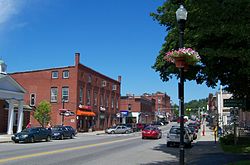Farmington, Maine
| Farmington, Maine | ||
|---|---|---|
| Town | ||

Downtown Farmington
|
||
|
||
| Nickname(s): F-Town, Farmtown, The Farm | ||
 Location in Franklin County, Maine |
||
| Location within the state of Maine | ||
| Coordinates: 44°40′8.37″N 70°8′46.96″W / 44.6689917°N 70.1463778°WCoordinates: 44°40′8.37″N 70°8′46.96″W / 44.6689917°N 70.1463778°W | ||
| Country | United States | |
| State | Maine | |
| County | Franklin | |
| Incorporated | February 1, 1794 | |
| Area | ||
| • Total | 55.82 sq mi (144.57 km2 km2) | |
| • Land | 55.67 sq mi (144.18 km2 km2) | |
| • Water | 0.15 sq mi (0.39 km2 km2) | |
| Elevation | 425 ft (130 m) | |
| Population (2010) | ||
| • Total | 7,760 | |
| • Estimate (2012) | 7,678 | |
| • Density | 139.4/sq mi (53.8/km2) | |
| Time zone | Eastern (UTC-5) | |
| • Summer (DST) | Eastern (UTC-4) | |
| ZIP codes | 04938, 04992, 04940 | |
| Area code(s) | 207 | |
| Website | farmington-maine.org | |
Farmington is a town in and the county seat of Franklin County, Maine, United States. As of the 2010 census, the town population was 7,760. Farmington is home to the University of Maine at Farmington, the Nordica Memorial Auditorium, the Homestead, and the annual Farmington Fair.
The area was once territory of the Canibas tribe of Abenaki Indians. They had two camps located near Farmington Falls, with fields cleared for cultivation of maize and potatoes. Their fort's enclosed about an acre at the center of what is today Farmington Falls village. A group from Topsham arrived in 1776 to explore the area and lay out a town, called Plantation No. 1 or Sandy River Plantation, but permanent settlement was delayed by the Revolutionary War.
In 1781, the first settlers arrived, the same year a sawmill was established. On February 1, 1794, Sandy River Plantation was incorporated as Farmington, named for its unusually fertile soil. Beginning with a cluster of log houses at Farmington Falls, the town grew quickly and prospered. Agriculture was an important early occupation, with hay a principal product. Orchards yielded apples and other fruit. Farmington became one of the largest wool producing towns in New England, with many herds of sheep grazing the hills and intervales.
...
Wikipedia


